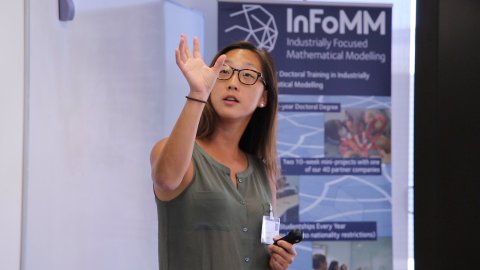15:45
Profinite rigidity and 3-manifolds
Abstract
Developments in geometry and low dimensional topology have given renewed vigour to the following classical question: to what extent do the finite images of a finitely presented group determine the group? I'll survey what we know about this question in the context of 3-manifolds, and I shall present recent joint work with McReynolds, Reid and Spitler showing that the fundamental groups of certain hyperbolic orbifolds are distingusihed from all other finitely generated groups by their finite quotients.
15:45
SU(2)-cyclic surgeries and the pillowcase
Abstract
The cyclic surgery theorem of Culler, Gordon, Luecke, and Shalen implies that any knot in S^3 other than a torus knot has at most two nontrivial cyclic surgeries. In this talk, we investigate the weaker notion of SU(2)-cyclic surgeries on a knot, meaning surgeries whose fundamental groups only admit SU(2) representations with cyclic image. By studying the image of the SU(2) character variety of a knot in the “pillowcase”, we will show that if it has infinitely many SU(2)-cyclic surgeries, then the corresponding slopes (viewed as a subset of RP^1) have a unique limit point, which is a finite, rational number, and that this limit is a boundary slope for the knot. As a corollary, it follows that for any nontrivial knot, the set of SU(2)-cyclic surgery slopes is bounded. This is joint work with Raphael Zentner.
15:45
Stable diffeomorphism of 4-manifolds
Abstract
I will talk about the diffeomorphism classification of 4-manifolds up to
connected sums with the complex projective plane, and how the resulting
equivalence class of a manifold can be detected by algebraic topological
invariants of the manifold. I may also discuss related results when one
takes connected sums with another favourite 4-manifold, S^2 x S^2, instead.
15:45
A Lie group analog for the Monster Lie algebra
Abstract
The Monster Lie algebra m, which admits an action of the Monster finite simple group M, was constructed by Borcherds as part of his program to solve the Conway-Norton conjecture about the representation theory of M. We associate the analog of a Lie group G(m) to the Monster Lie algebra m. We give generators for large free subgroups and we describe relations in G(m).
15:00
Dynamic Gauge Linear Sigma Models from Six Dimensions
Abstract
Compactifications of 6D Superconformal Field Theories (SCFTs) on four-manidolfds lead to novel interacting 2D SCFTs. I will describe the various Lagrangian and non-Lagrangian sectors of the resulting 2D theories, as well as their interactions. In general this construction can be embedded in compactifications of the physical superstring, providing a general template for realizing 2D conformal field theories coupled to worldsheet gravity, i.e. a UV completion for non-critical string theories.
16:00
Classifying Higgs bundles, stable and unstable
Abstract
The aim of this talk is to describe the classification problem for Higgs bundles and to explain how a combination of classical and Non-Reductive Geometric Invariant Theory might be used to solve this classification problem.
I will start by defining Higgs bundles and their physical origins. Then, I will present the classification problem for Higgs bundles. This will involve introducing the "stack" of Higgs bundles, a purely formal object which allows us to consider all isomorphism classes of Higgs bundles at once. Finally, I will explain how the stack of Higgs bundles can be described geometrically. As we will see, the stack of Higgs bundles can be decomposed into disjoint strata, each consisting of Higgs bundles of a given "instability type". Both classical and Non-Reductive GIT can then be applied to obtain moduli spaces for each of the strata.
16:00
Operads with homological stability and infinite loop space structures
Abstract
In a recent preprint, Basterra, Bobkova, Ponto, Tillmann and Yeakel
defined operads with homological stability (OHS) and showed that after
group-completion, algebras over an OHS group-complete to infinite loop
spaces. This can in particular be used to put a new infinite loop space
structure on stable moduli spaces of high-dimensional manifolds in the
sense of Galatius and Randal-Williams, which are known to be infinite
loop spaces by a different method.
To complicate matters further, I shall introduce a mild strengthening of
the OHS condition and construct yet another infinite loop space
structure on these stable moduli spaces. This structure turns out to be
equivalent to that constructed by Basterra et al. It is believed that
the infinite loop space structure due to Galatius--Randal-Williams is
also equivalent to these two structures.


